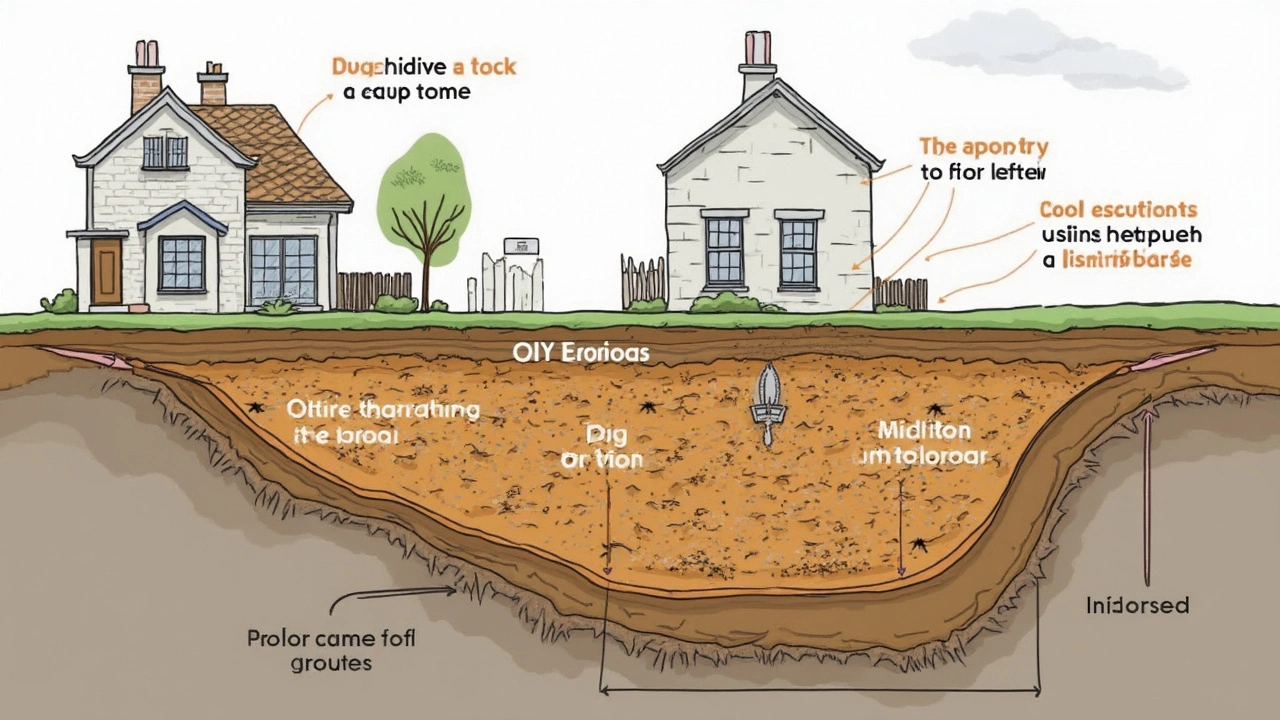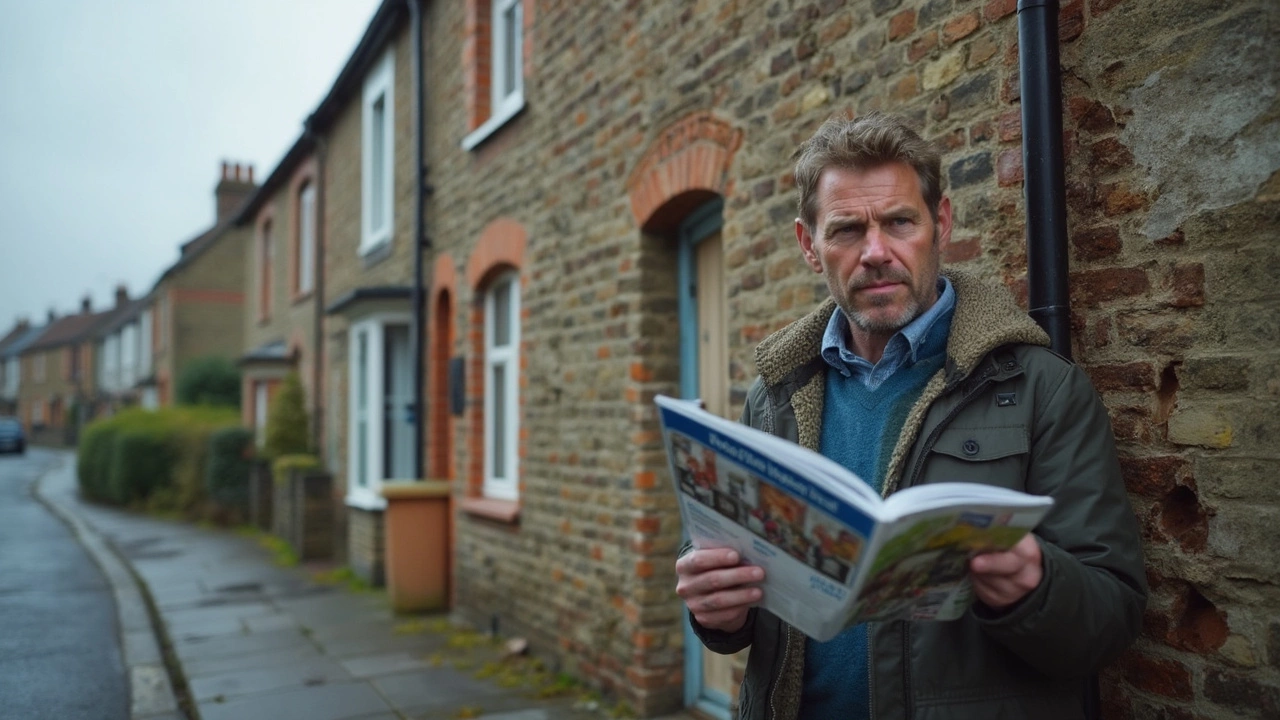Imagine walking across your living room and noticing the floor isn't level. Maybe a door sticks, or you spot a crack crawling along a wall. Stuff like this often means your foundation is on the move and, yep, it’s sinking.
Don’t panic—most homes face some settling, but when it crosses the line into sinking, it calls for some real action. Foundation issues don’t just make your house look weird—they can wreck your plumbing, damage walls, and even drive down the value of your home.
First things first: check for the signs before it gets worse. Catching foundation problems early can save you a ton of money later. If you know what to look for and when to bring in the pros, you’ll be way ahead of the folks who ignore the warning signs. Hanging tight and hoping cracks will “just settle” isn’t a plan. Ignoring it gives the problem time to get much worse.
- The Signs of a Sinking Foundation
- Why Does Your Foundation Sink?
- DIY Ways to Slow the Damage
- Professional Repair Methods Explained
- How to Prevent Future Sinking
- Common Myths and Mistakes
The Signs of a Sinking Foundation
Spotting a sinking foundation early makes all the difference. Some signs are easy to miss if you don’t know what to look for, while others stick out like a sore thumb. Even the pros say most people ignore the obvious until the floors start tipping like a funhouse.
- Sinking foundation clue #1: Cracks in walls—especially if they’re zig-zagging along drywall, or above door and window frames. Small hairline cracks pop up in most homes, but wide, growing, or angled cracks are a big red flag.
- Doors and windows that stick for ‘no reason’. If you suddenly have to wrestle the bedroom door shut or your morning routine turns into a battle with the bathroom window, that’s a classic signal your foundation is moving.
- Floors that aren’t level—roll a marble or small ball across a room. If it speeds to one side, you probably have trouble below. Sinking can mess with flooring, so look for bouncy, sagging, or warped spots too.
- Gaps around window frames or where walls meet the ceiling. Even small gaps can mean foundation movement.
- Cracks in the exterior—especially brickwork and steps. If bricks shift or cracks run through masonry, something is moving underneath.
Got a crawl space or basement? Look for pooling water or musty smells. Sinking often lets water in where it shouldn’t be, and moisture is a sign things are getting worse.
| Sign | What To Look For |
|---|---|
| Wall Cracks | Zig-zag, widening, or near doors/windows |
| Sticky Doors/Windows | Hard to open or close suddenly |
| Unlevel Floors | Marble rolls, floor sags or feels bouncy |
| Gaps & Spaces | Cracks along ceiling or exterior brick |
| Basement Signs | Pooled water, musty or moldy smells |
There’s no perfect checklist, but if you spot more than one of these, it’s time to look closer. Don’t just shrug off those sticking doors or tiny cracks—houses aren’t supposed to shift around like that. Checking your home each season just takes a few minutes, but it can save you a fortune down the road.
Why Does Your Foundation Sink?
A sinking foundation almost always boils down to soil and water problems. It’s not just bad luck—there’s a “why” behind every crack and slope you see inside your home.
Number one enemy: soil movement. Some soils swell up when they get wet and shrink when they dry out. This push and pull sends your foundation drifting up or down over time. Clay-heavy soils are especially notorious for this. Sand doesn’t hold water so much, so you’ll rarely see this extreme in areas built on sandy ground.
Water is the other big factor. Too much water under your house from bad drainage or a busted pipe can wash away soil. Too little water can dry out clay and cause it to pull back from the foundation, leaving you with voids. Both are bad news if you want your house to stay where you put it.
Trees and plants can mess with the soil too. Big tree roots draw water out of the ground, especially during hot summers, which means soil under your house can shrink faster right where you don’t want it to. On top of that, roots can sneak underneath and actually lift up parts of the slab.
Weather, especially big swings between wet and dry, just adds to the problem. If you live somewhere with hot summers and soaking rains, your foundation gets a lot of stress each year.
- Poor soil prep before building — didn’t compact well? Get ready for sinking later.
- Leaky plumbing or downspouts dumping water beside the house pile on the risk.
- Tons of clay or fill dirt? You'll see more movement than houses built on solid rock or sand.
| Cause | How It Affects Foundation |
|---|---|
| Clay soil | Expands and shrinks, causing movement |
| Poor drainage | Washes soil away below foundation |
| Tree roots | Take moisture out, soil shrinks, uneven support |
| Improper backfill | Settling over time, sinking areas under slab |
| Leakage | Constant moisture weakens soil strength |
So the next time someone shrugs and blames "old age" for a wobbly floor, remember: it’s all about what’s happening in the dirt and water right under your house. That’s why fixing those root causes beats just patching cracks every time.
DIY Ways to Slow the Damage
If you spot early signs that your sinking foundation is starting to move, you actually do have some options before calling the heavy hitters. Most fixes won’t reverse serious foundation issues, but they can help buy you time and might even keep small problems from blowing up. Here’s what really works:
- Control Water Around Your Home: Water is enemy number one when it comes to any foundation problem. Make sure your gutters are clear and your downspouts dump rainwater at least 6 feet from your house. Soggy soil puts pressure on your foundation and makes it settle faster.
- Re-grade the Soil: Check your yard and see if ground slopes toward your home. If it does, grab a shovel and build up the soil so it slopes away by at least 6 inches over the first 10 feet. This stops water from pooling next to your foundation.
- Seal Cracks: Small hairline cracks can be sealed yourself with a concrete caulking product from any hardware store. Keep in mind, this stops water and bugs, but won’t fix what’s going on under your house.
- Keep Soil Moist but Not Soaked: Dry soil shrinks and soaked soil expands—both can move your foundation. If you live where summers are dry, run a soaker hose along the edge of your foundation. Just a light, consistent trickle keeps the soil stable.
- Trim Heavy Trees: Roots can suck moisture from under your home or push against the foundation. Trim back or remove trees that are too close to your house (especially big ones like oaks and elms).
If you’re curious, here’s a quick snapshot of how much water can affect your home’s base, using data from the National Association of Home Builders:
| Water Source | Impact per Year |
|---|---|
| 1/2 inch rain on 2,000 sq ft roof | 600 gallons of water dumped |
| Leaky hose bib | Over 8,000 gallons wasted per year |
So yeah, a little water goes a long way—sometimes in a bad way. Stopping excess water is hands-down the best DIY move you can pull. Just don’t try jacking up the house or pouring your own concrete piers. That’s how a “small fix” turns into a lot of regret—and a bigger repair bill later.

Professional Repair Methods Explained
If you’re seeing major signs of foundation trouble like wide cracks, sloping floors, or doors and windows that won’t budge, DIY tricks won’t cut it. Here’s what the pros actually do to tackle a sinking foundation—and what works for the long haul.
There isn’t one fix that works for every sinking foundation. It depends on your soil, the layout of your house, and how far the damage has gone. But a few tried-and-true methods come up almost every time.
- Steel Piers: Contractors drive long metal piers deep into the ground to reach stable soil or bedrock. They attach these to your foundation and use hydraulic jacks to lift everything back into position. This method is strong, reliable, and good for even the heaviest houses.
- Helical Piers: These look like huge screws that get twisted into the earth. They’re great for lighter structures or houses where traditional piers can’t go. Helical piers go in fast and work for different soil types.
- Mudjacking (Slabjacking): If you’ve got a sunken concrete slab, pros pump a mixture of cement, soil, and water underneath to push it back to level. This fixes sidewalks, driveways, patios, and sometimes basement floors. It’s cheaper than piers but not as long-lasting for big-time sinking problems.
- Polyurethane Foam Injection: Similar to mudjacking, but with a modern twist. Instead of a heavy slurry, this method uses a special expanding foam. It’s quick and minimally invasive, but it’s usually best for smaller fixes.
Most reputable foundation companies start with a full inspection. Don’t trust anyone ready to sell you the priciest solution before looking at your whole property. Pros check for drainage issues, soil moisture, and past repairs before picking a solution.
| Method | Average Lifespan | Estimated Cost (per pier/area) |
|---|---|---|
| Steel Piers | 75+ years | $1,500–$2,500 |
| Helical Piers | 50+ years | $1,200–$2,000 |
| Mudjacking | 8–15 years | $500–$1,300 |
| Foam Injection | 8–10 years | $600–$1,800 |
Picking the right fix isn’t about going the cheapest route—it’s about stopping the sinking for good. If your house needs piers, don’t let anyone talk you into a quick patch job. Solid repairs can protect your house and wallet for decades. And if you ever sell, future buyers (and inspectors) can spot shoddy work from a mile away.
How to Prevent Future Sinking
If you’ve dealt with a sinking foundation, you probably never want to go through that headache again. The good news is, a few regular habits and fixes can help stop trouble from coming back. Most problems start with water or soil changes, so that’s where to focus.
Start with your gutters and drainage. Clogged or broken gutters will let water pool around your house. When that happens, the soil shifts or swells—pushing the foundation up, down, or sideways. Clean gutters every spring and fall, and make sure your downspouts send rainwater at least six feet away from the base.
- Look for pooling water after it rains. If water sits close to the house, regrade the soil so it slopes away. Aim for a slope of at least six inches over ten feet away from your foundation.
- Don’t plant big trees or shrubs right up against the foundation. Their roots can dry out or loosen the soil, and some roots have a bad habit of wedging into foundation cracks. Keep large plants at least 10-15 feet from your foundation.
- Fix plumbing leaks fast. Water from a leaky pipe can soak down and mess with the soil under your home.
Really dry summer? Give the soil around your foundation a little water slowly, but don’t overdo it. Too much water suddenly after a drought can make the soil swell and shift. A soaker hose can help if you set it up about a foot from the house and let it run slowly.
When my wife Lara and I fixed our own home’s drainage, it shocked us how big a difference it made. We haven’t seen any new cracks since.
Here’s how a few cheap habits can stack up against foundation headaches later:
| Strategy | Estimated Cost per Year | Chance of Preventing Issues (%) |
|---|---|---|
| Clean gutters twice/year | $0 (DIY) | 60% |
| Direct downspouts away | $20 | 45% |
| Check and repair grading | $0 (DIY) | 50% |
| Fix plumbing leaks fast | Varies | 40% |
When you keep water and roots in check, you cut your odds of sinking foundation problems in half. Skipping these steps might save you five minutes now, but it could cost you thousands later.
Common Myths and Mistakes
When it comes to a sinking foundation, there’s a lot of bad info floating around. Let’s clear up what works, what doesn’t, and which tips could actually make things worse.
The biggest myth out there? “Cracks are normal. All houses settle.” Sure, minor settling happens, but widening cracks or doors that suddenly stop closing are waving big red flags. Don’t just shrug it off.
Another mistake is patching wall cracks and thinking you’ve solved the problem. That’s just a Band-Aid. If your foundation is dropping, patching drywall won’t stop it from sinking more.
- Waterproof paint stops foundation leaks. Paint helps for surface moisture, but if water is coming through cracks because the foundation is shifting, no paint will fix it. Sorting your drainage outside is a better use of your time and money.
- Digging a trench and filling it with gravel under your foundation is a fix. This sounds simple, but it’s not effective. Foundations need proper support—gravel won’t magically lift a house.
- DIY hydraulic cement patches are permanent solutions. These work for minor fixes but not if the foundation’s moving. Cement patches will probably pop right off when things shift again.
It’s also common to think fixing one side of the house will fix the whole thing. Problems often come from uneven soil or drainage issues, so you can’t just lift one corner and call it a day.
If you’re still not sure, check out this table for some quick facts about foundation misconceptions and what’s really true:
| Myth | Reality |
|---|---|
| Foundation cracks are always harmless | Cracks wider than 1/4 inch and growing are a real problem |
| Pouring concrete near the foundation helps sinking | Extra concrete won't stop movement in most cases |
| Heavy watering near the home is helpful in dry spells | Too much water can cause soil to expand and make sinking worse |
| Jacking up a house is a safe DIY project | This is risky and can do more damage if not done by a pro |
Bottom line: Don’t trust shortcuts or “miracle fixes.” If you aren’t sure about a repair, ask a reputable local pro who actually fixes foundations (not just the guy with some quick concrete mix in his truck).





